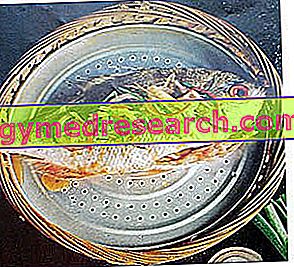What is steaming?
Steaming is a cooking technique; in particular it is a method of "convection", that is, it transmits heat through a secondary means placed between the heat generator and the food to be treated.

Steam cooking can be practiced with:
- Pots, casseroles and mufflers with a special steaming basket
- steamers
- Oven with steam function
- Pressure cooker.
Normally steaming can transmit around 100 ° C (water evaporation temperature) but, if combined with the pressure increase (up to 2 bar), the intensity can increase by 20%.
There is the possibility of steaming even under vacuum, thanks to the use of the special preservation system. It is a poorly used method because it is less effective than vacuum cooking for drowning or pot-forming.
Features and Differences
Characteristics of steam cooking
In general it could be defined that the characteristics of steam cooking are the following:
- It is slower
- It is less intense
- Preserves the organoleptic and taste characteristics
- Avoid nutrient dispersion
- Does not produce Maillard reactions
- It does not produce toxic molecules
- It is only suitable for the treatment of solid raw materials
- It is especially suitable for the treatment of raw materials that do not require excessively long cooking times, such as meat and fish products rich in connective tissue
- It is particularly suitable for delicate foods such as fish, white meats
(chicken, turkey, etc.), shellfish (shrimp, lobster, etc.), tubers (potatoes, Jerusalem artichokes) and vegetables
- Excludes the need for fat in cooking.
How does it differ from other cooking techniques?
Steam cooking differs from other cooking techniques in several respects.
Conduction cooks using the direct contact between a material / surface and the food, providing for the passage of heat between two adherent solid bodies (pan, plate). The radiation is based on the transfer of electromagnetic radiation (infrared and microwave - fire / embers and a special electric oven) from the source to the food, without any physical contact. Compared to the latter two, which require moving the food to make cooking uniform, in the convection it is instead the secondary means to move into the space surrounding the food. Furthermore, while drowning (bleaching / blanching) and frying (two other convection techniques) exploit a fluid convective medium (water and oil), the steamer uses a gas.
Steam cooking also has more or less specific features that help to differentiate it from other techniques. Let's look at them in more detail.
Advantages
What are the benefits of steaming?
Steam cooking is unanimously considered to be the healthiest cooking method, ideal - above all - for preserving the maximum vitamin and mineral content of foods.
Various and important advantages are attributed to the steam cooking of meat, fish and vegetables, compared to the use of other techniques:
- Preserves more the original organoleptic characteristics of the food, not only in terms of more lively taste, but also in terms of appearance (color) and texture. This is due to the treatment temperature (relatively low) and the slowness with which it reaches the food core. Moreover, it does not cause dilution of the aromatic components which remain mainly inside the tissues.
- Also thanks to the slowness and uniformity of heat transmission, it does not lead to the formation of substances that are difficult to digest, if not even toxic or carcinogenic, deriving from cooking at high temperatures (as happens when grilling or frying foods). However, it is not suitable for denaturing the collagen of certain meats (used for cooking or for broths) and the connective tissues of cephalopod molluscs (octopus, cuttlefish, etc.)
- It does not require the addition of various oils and condiments, which can possibly be added raw at the end of cooking. Moreover, the fat component that "melts" due to the effect of heat does not remain in direct contact with the food but descends into the boiling water (which does not happen, in addition to the traditional conduction techniques, not even in vacuum cooking and in vasocottura). In this way, steamed foods are easier to digest and less caloric; the steam is therefore a cooking method particularly indicated in case of slimming diets
- As anticipated, due to the contained temperatures and the lack of direct contact with the cooking water, the steam allows the preservation of a large part of the thermolabile vitamins contained in food (especially in vegetables) and of mineral salts
- It is a fairly practical but not always fast cooking method. We could define that the shorter the steam cooking, the greater the quantity of vitamins preserved; sometimes however, at the expense of digestibility.
- It does not require particularly expensive pots and utensils, which among other things are simple to clean at the end of cooking with savings on the use of detergents.
All these advantages, of course, are valid only if certain rules are respected during cooking.
Method
How to cook with steam? Practical rules and advice
The two types of domestic steam cooking
This cooking method exploits the ability of water vapor to transmit heat from outside the food, with which it comes into contact, inside it. At the domestic level there are two types of steam cooking:
- At ambient pressure : in which the steam is generated by the boiling of water at ambient pressure (1 bar); once it reaches 100 ° C it turns into steam and its temperature does not rise even providing additional heat to the system. A pot, the specific basket and a suitable lid are sufficient.
- At higher than environmental pressure : it is the operating principle of pressure cookers, in which - thanks to the presence of an airtight lid - the boiling temperature is higher (in the order of 120 ° C); this allows to reduce the cooking time to about 1/3, making it more practical and preserving the advantages expressed in the introductory part. The use of a pressure cooker with the specific steam cooking basket is required.
Indirect flavoring

Steam cooking "simple"
In general, if you do not have a pressure cooker or modern electric basket machines, you can simply get a large pot with very high edges and fill it halfway with water embellished with the addition of various spices. At this point it is necessary to use a fine mesh basket that MUST NEVER come into contact with water and which must be covered by a tight cover in order to avoid the dispersion of steam.
Tips for steaming
- Not having a suitable lid, as an alternative it is possible to use an aluminum sheet or a transparent film to limit the dispersion of steam from the pot.
- As an alternative to the steam cooking basket, a metal sieve can be used for the first experiments.
- The base of the basket, being in stainless steel, can possibly be lined with baking paper to prevent the food from sticking; the latter must be positioned on the basket when the water is already boiling, preferably cut into thin layers to even out the cooking, distributing the heat better.
- To best preserve nutrients and organoleptic characteristics, the vegetables should be cut just before placing them on the basket.
- The fire will be moderate throughout the steaming time, in order to limit the possibility that the boiling liquid reaches the basket or the food.
- Steam cooking times depend, of course, on the type of food and its thickness; for green leafy vegetables it may take a couple of minutes, which instead rise to 10 or more for vegetables such as potatoes and carrots.
- It is possible to cook fresh legumes (especially broad beans, peas, jackdaws, green beans) but, due to the tenacity of the skin, dry ones (even if rehydrated) are less suitable.
Cotechino Light (steamed) and Lentils
Steamed Buns - Chinese Bread
X Go to the Video Page Go to the Video Recipes Section Watch the video on youtube



